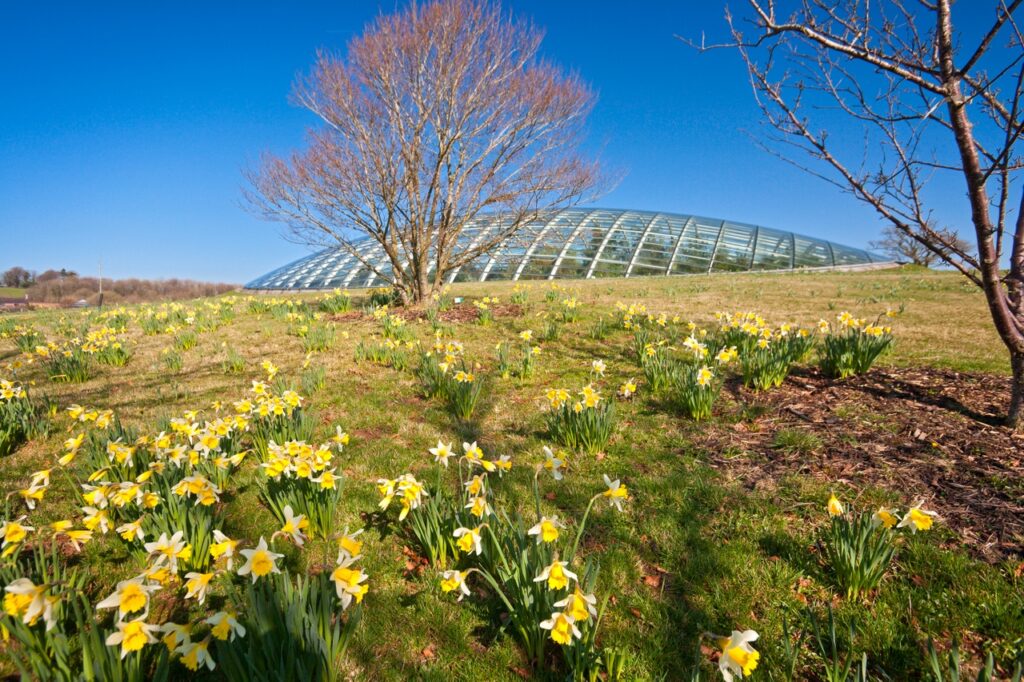The National Botanic Garden of Wales

THE National Botanic Garden of Wales is a botanical garden located at Middleton Hall, Llanarthne, in the River Tywi valley, Carmarthenshire.
The garden is both a visitor attraction and a centre for botanical research and conservation, and features the world’s largest single-span glasshouse, measuring 360ft long by 200ft wide.
The National Botanic Garden of Wales states its aim is “to develop a viable world-class national botanic garden dedicated to the research and conservation of biodiversity, lifelong learning and the enjoyment of the visitor.”
Plants from several Mediterranean climate regions in the Great Glasshouse are divided into sections from Chile, Western Australia, South Africa, California, the Canary Islands and the Mediterranean itself.
A Double Walled Garden has been developed to house a wide variety of plants, including a modern interpretation of a kitchen garden in one quarter and ornamental beds to display the classification and evolution of all flowering plant families in the other three quarters.
With a living collection of around 6,000 different types of plant, the garden offers visitors an incredible feast of botanical choice, including an orchard of Welsh apple varieties and a nationally important collection of rare Welsh native plants.
The Arboretum is one of the most ambitious collection projects. Added to these are plants specifically chosen for themed gardens such as the Japanese Garden, Broadwalk displays, Boulder Garden, Wild Garden, Wallace Garden, Growing the Future Garden, Apothecary’s Garden and Slate Beds.
The collections are not only a sensory treat throughout the year for all visitors, but fulfil a vital educational and conservational role. They are used for the study of botany, ecology, horticulture, sustainability, maths, culture and medicines. Researchers from academic and practical backgrounds also use the collections to observe and investigate conservation issues that benefit the ecology of Wales, the UK and countries around the world.
In partnership with the Centre for Alternative Technology, Machynlleth; Insole Court, Llandaff; Treborth Botanic Garden, Bangor University; the Woodland Skills Centre, Denbighshire and Clydach Community Garden, Swansea, the Growing the Future project at the National Botanic Garden of Wales is working to champion Welsh horticulture, plants for pollinators, the protection of wildlife and the virtues of growing plants for food, fun, health and well-being.
The British Bird of Prey Centre is an outstanding addition to the many splendours of the garden, establishing a special attraction where visitors can see eagles fly every day.
The British Bird of Prey Centre is home to 20 native birds of prey, including hawks, falcons, kites and buzzards, as well as eagles.
There are also opportunities for visitors to fly the birds themselves. Owl and Red Kite taster sessions offer the opportunity to have these birds fly to your glove. Private bookings are also available.
The centre was officially opened by the Tourism Minister Lord Dafydd Elis-Thomas on July 9, 2018.
The Waun Las national nature reserve can be accessed from the garden and comprises some 150 hectares (370 acres) of wildflower meadows, pastures and arable fields. The area is managed not only as an organic working farm, but one that actively encourages the spread of native wild plants.
Welsh black cattle and Welsh breeds of sheep, varieties that are well suited to local soils and weather, graze the wet and dry pastures.
The farm operation is run from Pantwgan Farm, on the northern perimeter of the garden site. This is where sheep go for lambing in spring and where cattle go to keep out of the winter cold.
A network of footpaths allows garden visitors to safely explore the farm at their leisure.
(sources include botanicgarden.wales, Wikipedia)
Back to HOME PAGE